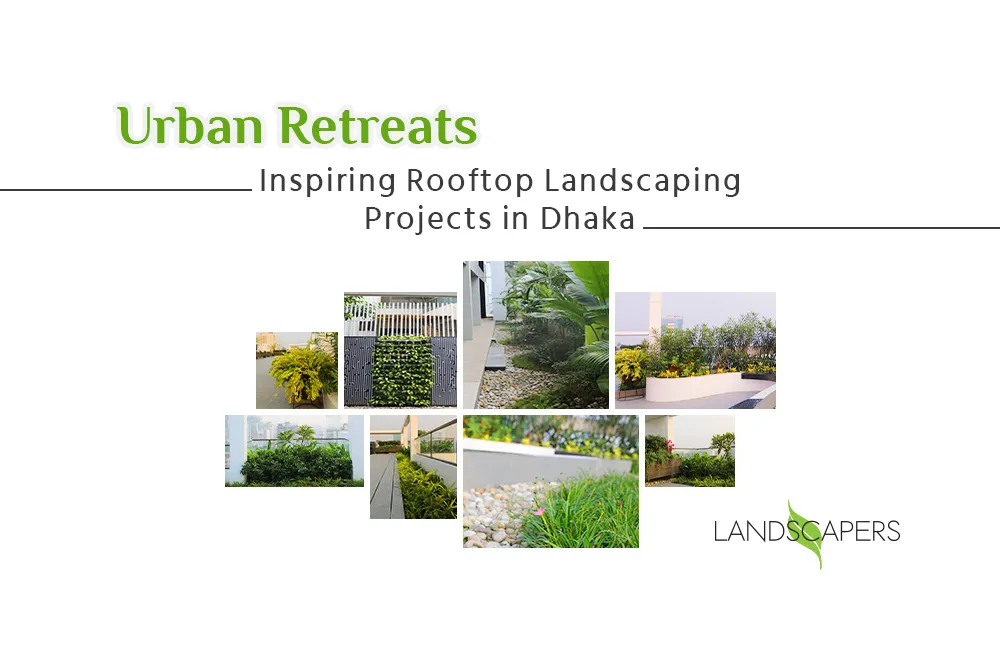
Urban Retreats: Inspiring Rooftop Landscaping Projects in Dhaka
In an urban metropolis like Dhaka, living in the concrete jungle can often feel suffocating. The mind can begin to thirst for just a little touch of greenery. In the midst of the relentless march of urbanisation and the distressing scarcity of lush landscapes, a captivating solution has gracefully blossomed- the opulent urban rooftop gardens. These ethereal oases are not a recent innovation, but rather an enduring testament to humanity’s resourcefulness and unyielding bond with the natural world. From the ancient Hanging Gardens of Babylon, people have always tried to experiment with landscaping on rooftops. However, the 20th-century versions are a modern innovation, as well as being a means of creating a more sustainable environment, which is a practical need in today’s world.
Landscaping projects can be done with the help of architectural firms with landscaping facilities, or with developers that provide individualised landscaping services. You can also choose to hire one of the landscapers independently to design the rooftop of your dreams. The epitome of opulence, urban rooftop gardens, commonly referred to as green roofs, encompass the exquisite practice of adorning architectural marvels with lush vegetation. Ranging from simple setups with ground cover plants to more intricate arrangements including trees, shrubs, and a variety of plant species–there are endless possibilities when it comes to urban rooftop landscaping. Some green roofs are even used for urban farming, with herbs, fruits, vegetables, and herbs grown for local or personal consumption.
Urban rooftop landscaping requires detailed planning and proper execution for it to be successful. When architects and landscapers are given enough creative freedom, they can often come up with amazing masterpieces–and this can be further catered to suit one’s individual style, budget and space available. Incorporating a rooftop garden into architectural design is laborious, especially since there are unique demands that need to be fulfilled. The structural integrity of the building’s rooftop must first be examined to see whether the roof is strong enough to support the extra weight due to the soil, plants, water and the pots/ implements that will be used to tend to the lush foliage. A waterproofed and well-insulated rooftop garden is an absolute must, because this will ensure the building is safeguarded from potential leaks and damage from water. A rooftop garden will also need a good drainage system to ensure the prevention of waterlogging. Waterlogging can seriously damage both the plants and the roof’s structure. Succulents and perennials can be a good solution to this problem as they require minimal care and can even flourish in tough climates with very little water.
While choosing which plants to use in your landscaping project, keep in mind the local climate, the amount of sunlight received on the roof, the maintenance capacity, and how much time and money the installations will cost. Delving deeper into the realm of urban rooftop gardens, we can discover a realm of opulence that transcends mere aesthetics. These elevated havens enhance the visual grandeur of our urban landscapes, and bestow upon us a myriad of environmental and social benefits. By embracing these green sanctuaries, we embrace a harmonious coexistence with nature, fostering a sustainable future for generations to come. Rooftop gardens can improve air quality by absorbing carbon dioxide and releasing oxygen. They can also help to mitigate the urban heat island effect, a phenomenon where urban areas are significantly warmer than their surrounding rural areas due to human activities.
These rooftop spaces can also serve as valuable habitats for a myriad of insects, birds and other small animals, contributing to urban biodiversity. In terms of water management, rooftop gardens can absorb and filter rainwater, which could reduce runoff and the risk of flooding. Rooftop gardens can also prove to be socially beneficial. In a city where there is no space to think for yourself and breathe fresh air, having a rooftop garden can provide valuable recreational and communal spaces. They also offer opportunities for city dwellers to engage in gardening or farming, promoting a connection with nature, which can undoubtedly be relaxing and soothing to the senses.
Terracing and vertical gardening can be unusual landscaping options that make the most of the available space. Vines or climbing plants can also give aesthetic appeal to an already beautiful rooftop. When doing landscaping on your rooftop, imagine it to be like an outdoor living room, where it can be your sanctuary when you need some much needed peace and quiet. Fences and planters can be used with a combination of vines to create a living green screen that gives seclusion and privacy to one area of your rooftop. Adding some softness to the decor of your rooftop will also soften it, giving it a cosy and homey feel. You can add some multi-coloured throw pillows, a few rugs and even some ottomans to give the rooftop garden a softer, homier feel. Choose what you would want from your rooftop garden, and ask your landscaper to incorporate your ideas accordingly. A perfectly landscaped rooftop can be the best reason for extending your hours of enjoyment–you can have family time during the day, and fun events with friends and neighbours later in the evening. Using suitable lights can only add to the evening ambiance.

